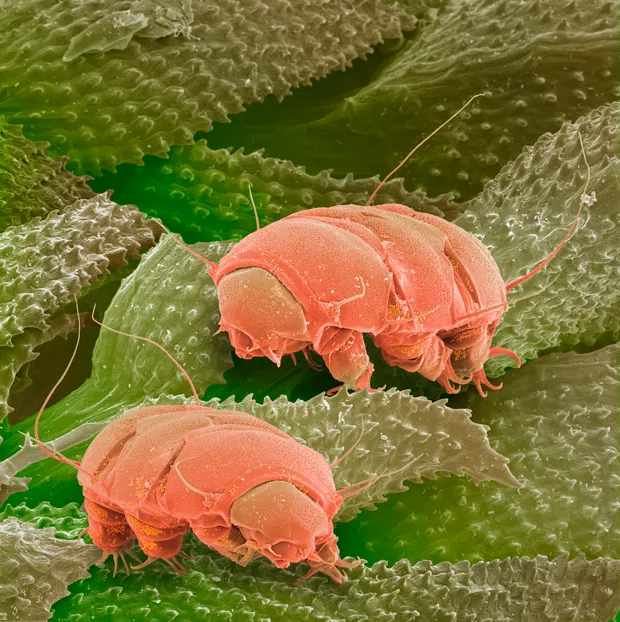Back in 1935, Albert Einstein and colleagues hypothesised that quantum theory predicted a remote linkage between particles, called quantum entanglement. Einstein took an instant dislike to the idea, calling it “spooky action at a distance”. He hoped that the existence of quantum entanglement meant that quantum theory, which he wasn’t too keen on to begin with, was somehow flawed, or not yet fully understood.
Quantum entanglement is a bizarre offshoot of quantum theory that says certain properties of a pair of particles become linked together in such a way that if you measure the value of one of them, then you instantaneously know the state of the other, even if they are separated by cosmic distances. Weird, eh? Sadly for Einstein, quantum entanglement has been demonstrated to be true many times, but so far only on a subatomic level.
Quantum theory describes the workings of the Universe’s smallest known components, predicting the behaviour of electrons and atoms, molecules and photons of light. And it does so incredibly well: eminent physicist Richard Feynman pointed out that quantum theory is so accurate it’s like predicting the distance between New York and Los Angeles to the width of a human hair. Yet quantum particles behave totally unlike everyday objects on a more human scale.
Too weird for Einstein
One of the key tenets underlying quantum theory is the idea that a particle can be in more than one place at any given time. Oddly, when not interacting with the world around them, or having their positions specifically measured, quantum particles don’t have a specific location. Instead, all that exists is a collection of probabilities of where the particle could be at any given time – a so-called superposition of states. It is this phenomenon that leads to Schrödinger’s cat being both alive and dead.

This gives us a puzzling distinction between everyday macroscopic objects, which obey the predictable precision of ‘classical physics’, and the microscopic world of tiny objects – ‘quantum physics’ – where probability rules. Einstein was so appalled at this idea it led him to say: “I would rather be a cobbler, or even an employee in a gaming house, than a physicist.”
When Einstein raised his objections to entanglement in the 1930s, it wasn’t possible to experimentally verify it. But by the 1970s it became feasible, and successful entanglement experiments have been run many times since.
There are even several practical applications of entanglement. One is quantum encryption. It takes inspiration from an idea by the American banker and cryptographer Frank Miller, who was working on the creation of an unbreakable cipher called a ‘one-time pad’ around 100 years ago. His idea was to give both sender and receiver a key made up of random values, but the approach was not 100 per cent secure because this key would have to be sent to both sender and receiver and so could be intercepted.
However, as quantum entanglement automatically provides random values even at widely separated locations, and also makes it possible to check whether particles have remained entangled, it would be impossible for a third party to read the random key before the particles reach their destinations. Chinese researchers have tested this principle, sending entangled photons to locations 1,200 kilometres apart.
Teleportation device
Quantum entanglement also makes quantum teleportation possible. Without entanglement it’s not possible to copy a quantum particle, because observing it will change the particle’s properties into a specific state. But quantum entanglement can transfer the state from one particle to another without altering it. This is like a small-scale version of a Star Trek transporter, though real teleportation makes a remote copy, scrambling the original, rather than moving it.

In practice, using teleportation on people would be impractical as they contain too many atoms. But the process can transfer quantum information from place to place, which is essential when building quantum computers. In standard computing, bits have values of 0 or 1. With quantum computing, bits are replaced with qubits, combining probabilities of 0 and 1 simultaneously, making it possible for special programs to run far faster than on a conventional computer.
Even outside of the lab, quantum phenomena are occurring all of the time. Any interaction between matter and other matter or light is a quantum process. All electronic devices rely on quantum phenomena, and even the Sun wouldn’t work were it not for the probabilistic nature of the location of quantum particles enabling hydrogen nuclei to get close enough together to fuse and produce energy.
There is also increasing awareness of quantum processes in biology. For example, photosynthesis, used by plants to generate energy from light, seems to use quantum effects to channel energy to the appropriate part of the plant.
Entanglement also may enable pigeons and robins to navigate. These birds detect the Earth’s magnetic field, apparently due to quantum entanglement in their eyes. Light coming into the eye boosts the energy of electrons. A property of the electrons called ‘spin’ is then influenced by tiny variations in the Earth’s magnetic field, and it is thought that quantum entanglement makes it possible for the bird to build a picture by linking different electrons.
Scaling up
But can quantum phenomena apply to objects bigger than tiny atoms or molecules? The answer appears to be yes. Dr Simon Gröblacher of Delft University of Technology and his colleagues have entangled two microscopic silicon bars. These bars measure 10 x 1 x 0.25 millionths of a metre, making them finer than a human hair. They have tiny pockets inside them that absorb energy from laser light which causes them to vibrate. The laser light is set up in such a way that the vibrational states of the bars become linked via quantum entanglement.

This is highly unusual. Usually in an object of this size, interaction between different atoms within the object, and with any atoms it comes into contact with, destroys entanglement in a process known as ‘decoherence’. So if it is possible to entangle a pair of silicon bars, how big could we go? Could we entangle living organisms?
Quantum biology is still a young field, but inspired by experiments such as Gröblacher’s, some scientists are devising experiments to use quantum effects to produce superpositions and entanglement in living organisms.
One group believes that this has already happened. In 2016, Dr David Coles of the University of Sheffield and his colleagues sent light bouncing across a narrow gap between two mirrors, through green sulphur bacteria. The experiment was devised to study photosynthesis, but when subsequently analysing the data, a group led by quantum physicist Dr Chiara Marletto at the University of Oxford discovered evidence that molecules inside the green sulphur bacteria had become entangled with the photons of light.

They are not 100 per cent certain of the effect, as proving entanglement would require measurements of the photons and the bacteria independently, and this wasn’t possible in their particular experiment. Marletto admits that dealing with living organisms is far harder than quantum particles.
“In quantum biology the molecules are very messy, and it is hard to perform accurate measurements,” she says. “What one would have to do is to isolate a single biomolecule [a molecule in a biological organism] within the bacterium and demonstrate that it is entangled with light,” she says.
Into the real world
But if such entanglement does occur, it could possibly be a survival mechanism that the bacteria use to harvest the scarce light in the deep oceans. And if entanglement were proven, it would open up a wealth of further possibilities.
“There has been a long-standing debate about whether quantum theory applies to all scales. The experiment shows that biomolecules in living entities are perfectly capable of displaying quantum effects by being entangled with light. The remarkable thing also was that the bacteria were alive throughout the experiment,” says Marletto.
To investigate the phenomenon further, Dr Tristan Farrow, one of Marletto’s colleagues, has proposed a new study to entangle a quantum property in a pair of bacteria. Although initially limited to a single property, Farrow believes the experiment could be taken further.
“Entangling living bacteria is a first step towards assessing the feasibility of implementing teleportation in bacteria,” he says. “Big, hot and messy systems such as biomolecules, never mind living organisms, have long been thought to be hostile environments for quantum states to survive for any meaningful length of time. We don’t know whether this is always true, or whether certain sub-structures inside these complex molecules can shield quantum states from the hostile environment.”
And there could be practical applications, too. “Bio-inspired quantum computing is an applied aspect of our research, aiming to reverse-engineer artificial structures inspired by biology,” says Farrow. “A prime example would be an artificial leaf to harvest light energy with extreme efficiency inspired by how certain photosynthetic molecules might use quantum superpositions to transport energy captured from sunlight.”

Gröblacher is also interested in experiments involving living creatures. He is currently working on putting a sheet of nitride into a superposition of states. By using a laser, it is theoretically possible to get a barely visible membrane of silicon nitride measuring around one millimetre across into a superposition of vibrations with two different amplitudes. The amplitude is related to the amount of energy carried by a wave, and is the measurement from the undisturbed position to the peak of the wave. If you apply more force, the peak – and therefore amplitude – increase. Gröblacher reckons they are within a couple of years of achieving this superposition of vibrations.
“A superposition state of these membranes would allow us to demonstrate that objects that are visible to the naked eye still behave quantum, and we can really test decoherence – the transition between classical and quantum mechanics,” he says.
He then hopes to extend the experiment by placing tiny living organisms called tardigrades onto the membrane of silicon nitride, putting them into superposition too. One of the remarkable abilities of tardigrades is their ability to survive being dehydrated. The tardigrades would be in their dehydrated state during the experiment so that there would be no impact on their biology. If successful, Gröblacher’s tardigrades would be the closest we’ve come to seeing a living creature in two simultaneous states – a real-life Schrödinger’s cat.
This is an extract from issue 331 of BBC Focus magazine.
Subscribe and get the full article delivered to your door, or download the BBC Focus app to read it on your smartphone or tablet. Find out more
Follow Science Focus onTwitter,Facebook, Instagramand Flipboard

